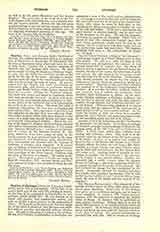

Cyprian, Saint, and JUSTINA, Saint, Christians of Antioch who suffered martyrdom during the persecution of Diocletian at Nicomedia, September 26, 304, the date in September being afterwards made the day of their feast. Cyprian was a heathen magician of Antioch who had dealings with demons. By their aid he sought to bring St. Justina, a Christian virgin, to ruin; but she foiled the threefold attacks of the devils by the sign of the cross. Brought to despair Cyprian made the sign of the cross himself and in this way was freed from the toils of Satan. He was received into the Church, was made preeminent by miraculous gifts, and became in succession deacon, priest, and finally bishop, while Justina became the head of a convent. During the Diocletian persecution both were seized and taken to Damascus where they were shockingly tortured. As their faith never wavered they were brought before Diocletian at Nicomedia, where at his command they were beheaded on the bank of the river Gallus. The same fate befell a Christian, Theoctistus, who had come to Cyprian and had embraced him. After the bodies of the saints had lain unburied for six days they were taken by Christian sailors to Rome where they were interred on the estate of a noble lady named Rufina and later were entombed in Constantine’s basilica. This is the out-line of the legend or allegory which is found, adorned with diffuse descriptions and dialogues, in the unreliable “Symeon Metaphrastes“, and was made the subject of a poem by the Empress Eudocia II. The story, however, must have arisen as early as the fourth century, for it is mentioned both by St. Gregory Nazianzen and Prudentius; both, nevertheless, have confounded our Cyprian with St. Cyprian of Carthage, a mistake often repeated. It is certain that no Bishop of Antioch bore the name of Cyprian. The attempt has been made to find in Cyprian a mystical prototype of the Faust legend; Calderon took the story as the basis of a drama: “El magico prodigioso”. The legend is given in Greek and Latin in Acta SS. September, VII. Ancient Syriac and Ethiopic versions of it have been published within the last few years.
GABRIEL MEIER

